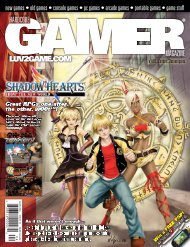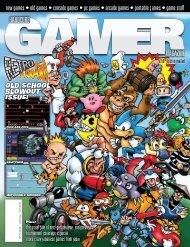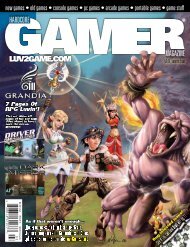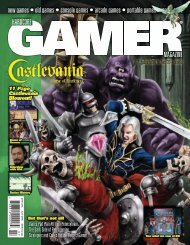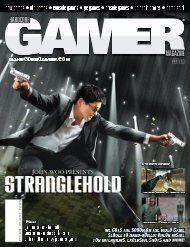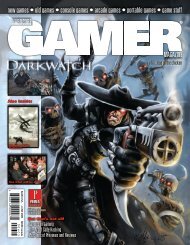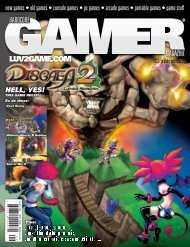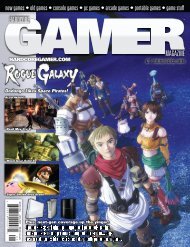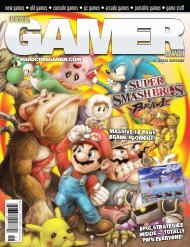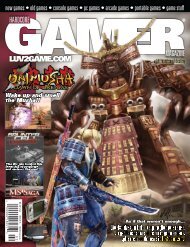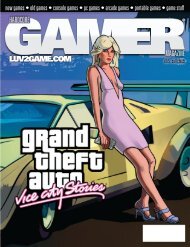Volume 2 Issue 6 December 2006 Sony ... - Hardcore Gamer
Volume 2 Issue 6 December 2006 Sony ... - Hardcore Gamer
Volume 2 Issue 6 December 2006 Sony ... - Hardcore Gamer
Create successful ePaper yourself
Turn your PDF publications into a flip-book with our unique Google optimized e-Paper software.
In 1995, Nintendo announced that its<br />
Nintendo 64, the nal name of the console,<br />
would use cartridges instead of CDs. This<br />
meant far less storage space for a much<br />
higher price. Nintendo preferred<br />
going with cartridges because it<br />
would make piracy harder, but the<br />
decision would later have severe<br />
consequences for Nintendo.<br />
<strong>Sony</strong> and Sega launched<br />
their systems in the United<br />
States in 1995. Despite<br />
promising to launch the Saturn on<br />
“September second, Sega Saturn Saturday,”<br />
Sega released its console in May, trying to<br />
avoid direct comparison with the superior<br />
PlayStation. The Saturn launched for $399<br />
and sold poorly.<br />
On September 9, <strong>Sony</strong> launched the<br />
PlayStation with only 100,000 consoles in<br />
its inventory. Needless to say, <strong>Sony</strong> sold<br />
out. More importantly, having sold a mere<br />
100,000 units, <strong>Sony</strong> was already ahead of<br />
Sega in the United States.<br />
The beginning of the end had come for<br />
Sega. Having launched the Saturn, Sega<br />
practically abandoned the Genesis and the<br />
19 million Genesis owners in the United States.<br />
The following year, Sega released a raft of new<br />
Genesis titles; but by that time, Genesis owners<br />
had already packed their game consoles away.<br />
The big winner in 1995 was Nintendo of<br />
America, but not because of the Virtual<br />
Boy, of course. <strong>Sony</strong> had sold a few hundred<br />
thousand game consoles in the United States<br />
and Sega had sold even less Saturns. Nintendo<br />
had complete control of the burgeoning 16-bit<br />
market that Christmas and made a fortune.<br />
Their fortunes were changing, however. Though<br />
the Saturn initially sold better than any other<br />
Sega system in Japan, the PlayStation soon<br />
overtook it. In 1996, when Nintendo released<br />
the N64, it looked like Nintendo would retake<br />
the market. Instead, the N64 ran out of gas.<br />
The system launched with only three games<br />
in Japan: Mario 64, Pilotwings 64, and<br />
Shogi. Although Nintendo sold Mario 64<br />
at an astounding one-for-one rate with<br />
the N64 hardware, few new games<br />
launched over the next three months.<br />
Mario 64, Pilotwings 64, and Shogi<br />
were still pretty much all you had<br />
to play.<br />
<strong>Sony</strong> had a huge game library<br />
that grew rapidly. <strong>Sony</strong> overtook<br />
Nintendo rst, and within a<br />
year eclipsed the Saturn. In<br />
America, Nintendo 64 looked<br />
to overtake the PlayStation at launch but fell<br />
short. The Saturn was never a contender.<br />
Having <strong>Sony</strong> in the mix permanently and<br />
irrevocably changed the landscape of the video<br />
games industry. Before <strong>Sony</strong> entered the ring,<br />
Sega and Nintendo entertained young players<br />
until they left for college, then patted them<br />
on the back and said, “Hope you’ll return some<br />
day when you have children of your own.”<br />
<strong>Sony</strong> was different. <strong>Sony</strong> was something<br />
for older brothers; it was an appliance you<br />
wouldn’t mind showing to the other kids in<br />
your dorm. Sega, a company that had built its<br />
reputation wrestling fourteen-year-olds out of<br />
Nintendo’s camp, seemed to be of the opinion<br />
that boys lost interest in video games as they<br />
became interested in girls. Nintendo seemed to<br />
back away from anyone old enough to have zits.<br />
Sega, a company that generally operated on<br />
the brink of nancial bankruptcy, could not<br />
compete in this new climate. In 1998, with<br />
<strong>Sony</strong> controlling more than half the market,<br />
Sega dropped the Saturn and returned to the<br />
drawing board. Nintendo continued to limp<br />
along with one-third of the market. Over<br />
the last three generations, Nintendo<br />
of America had dropped from<br />
approximately 93 percent of<br />
the market with the NES, to<br />
approximately 48 percent<br />
of the market (in 1993-<br />
1994) with the Super<br />
NES, to approximately 30<br />
percent of the market<br />
with N64.<br />
Nintendo’s attempts to<br />
follow <strong>Sony</strong>’s lead were<br />
fruitless. <strong>Sony</strong> and Eidos lit<br />
up the crowds by sending out<br />
models dressed like Lara Croft<br />
from Tomb Raider, so Nintendo<br />
NO<br />
STOPPING<br />
stuck a model in Lycra and called her Joanna<br />
Dark. <strong>Sony</strong> had edgy games full of violence and<br />
dark humor, so Nintendo gave a uffy squirrel<br />
named Conker a drinking problem and sent him<br />
out in elds of dung.<br />
In 1998, Sega announced plans for the<br />
Dreamcast, a game system that was clearly<br />
more powerful than the N64 or PlayStation.<br />
Howard Lincoln, the outspoken chairman<br />
of Nintendo of America, said that it was<br />
completely irresponsible of Sega to release a<br />
new system considering its nancial problems.<br />
Lincoln was right.<br />
The Dreamcast faced<br />
more than just<br />
nancial problems,<br />
though. It faced<br />
<strong>Sony</strong> at the height<br />
of its popularity.<br />
Sega’s Dreamcast had<br />
a lackluster launch in<br />
Japan in November 1998.<br />
The system was powerful,<br />
backed by great games,<br />
and inexpensive, but due<br />
to manufacturing glitches,<br />
Sega did not have many<br />
consoles to sell that opening day.<br />
Opportunity missed became opportunity<br />
lost as three months later, <strong>Sony</strong> made its<br />
big announcement. Held in a lavish Tokyo<br />
concert hall with fteen hundred journalists,<br />
game industry luminaries, and analysts in<br />
attendance, <strong>Sony</strong>’s press conference was<br />
meant to dazzle. It did. The Dreamcast<br />
became all but forgotten as <strong>Sony</strong> promised<br />
millions of polygons, DVD playback, and<br />
backwards compatibility.<br />
When Sega launched the Dreamcast in<br />
America on 9/9/99 for $199, the<br />
mass market refused to listen.<br />
Sega did many things right with<br />
the Dreamcast and it remains<br />
a favorite console among<br />
enthusiasts, but the <strong>Sony</strong><br />
juggernaut was not to be<br />
stopped.<br />
By the time <strong>Sony</strong> launched its<br />
PlayStation 2 in Japan, <strong>Sony</strong><br />
had sold over eighty million<br />
PlayStation consoles worldwide.<br />
The PlayStation 2 appeared on the<br />
cover of Newsweek Magazine. The<br />
launch was covered worldwide while<br />
Dreamcast sales all but died out in Japan.<br />
5 3 5 3<br />
3<br />
5<br />
46_COVER STORY_PLAYSTATION 3<br />
HARDCORE GAMER MAGAZINE_VOLUME 2_ISSUE 6_ELECTRIC PEEN<br />
© <strong>2006</strong> Layout and Design <strong>Sony</strong> Pictures Home Entertainment Inc. All Rights Reserved.<br />
Playstation ® is a trademark of <strong>Sony</strong> Computer Entertainment. Blu-ray Disc is a trademark.




